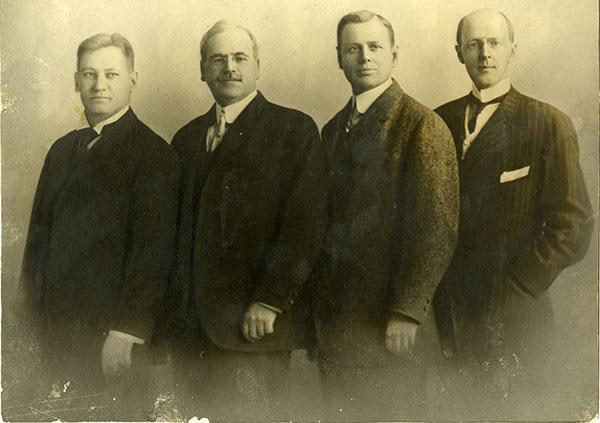 This is why historians don’t get invited to the *good* parties. We’re… boring.
This is why historians don’t get invited to the *good* parties. We’re… boring.I had an idea stuck in my head that wouldn’t go away. The history of District 5710. Oh, not an interesting, people-focused history full of fascinating people, projects with great impact, fun little observations. Nooooo.What about a territorial delineation? (Yeah, we talk like that – see comment about parties, above)
Thank heavens for the internet that Al Gore founded and that Tim Berners-Lee made useful. And for people who scan books that 99.8% of the population could care less about. Like, the Proceedings of the Rotary International Convention. Especially up through the 70s, when they were the primary source of Rotary history, along with Rotarian magazine. All of which are available on-line via Google Books and I didn’t have to spend the money to go to Evanston, find out where they stored that stuff (or which university library had them) and pore through that stuff page-by-page while eating travel costs as this job pays bupkus and doesn’t have a travel budget. Thank the Lord for hypertext mark-up language (html) and the “search and find” functions!
I still had to go through 60-some books to produce this bit (some years ago, but recently updated) that no one besides me read. Which may still be true if you don’t keep reading, so I’ll stop whining.
Here we go:
History of District 5710
History of District 5710
Rotary began in Chicago, Illinois in 1905 under the inspiration and leadership of Paul Harris, Gustavus Loehr, Silvester Schiele, and Hiram E. Shorey. In the early days, clubs were given names based on their location and numbered in sequence according to their charter dates. The Ur-club for our district was the Rotary Club of Kansas City, Missouri, Club 13, chartered in 1910, which sponsored the Topeka Rotary Club 130 in 1914. But Topeka was not the first Kansas club. Now in our sister district in Kansas, the Rotary Club of Wichita, Club 30, was sponsored by the Rotary Club of Oklahoma City in 1911 and thus justly lays claim to the start of Rotary in Kansas. But we were once all in the same district.
Other early clubs were:
Club Year Founded Original Number
Other early clubs were:
Club Year Founded Original Number
Kansas City, KS 1916 195
Leavenworth 1916 210
Lawrence 1917 304
Emporia 1917 311
Junction City 1917 330
Manhattan 1917 335
Atchison 1918 430
Rotary more than doubled in size and scope during WWI.
Rotary more than doubled in size and scope during WWI.
Early District Structures
Until 1913 all Rotary clubs were administered from Chicago. From 1912 to 1915 Kansas was a part of the Western Division governed by Vice Presidents from Wichita, Dallas, and Houston. Topeka was the only club in the present district then in existence. From 1915-1917 much of eastern Kansas was in the newly-formed 11th District with governors from Topeka and Kansas City, Missouri.
Moving to the 17th District from 1917 to 1922, the district featured governors from clubs scattered from St Louis to Wichita to Oklahoma City. We then bounced around in the 12th District from 1922 to 1926 and the 8th District from 1926 to 1937. At that time, the 8th District included most of Kansas (except the southeast corner), Oklahoma, and western Texas. For a part of that time, the Kansas City, Kansas club was part of the 15th District, which was most of Missouri, southeast Kansas, northwest Arkansas and eastern Oklahoma.
Since 1937, District 5710 has looked much like it does today, with the exception of adding Linn County in 1996 and the Rotary Club of Howard moving to District 5690 in 2016. Our numbers have changed over that time: #123, 1937-49; #180, 1949-57; #571, 1957-91; #5710, 1991-Present.
Rotary districts are essentially population-based. Like congressional districts, Rotary districts are drawn to be somewhat equal in population, as RI-level governance is based on Districts, with governors acting as the representative. Hence, the size and shape of the districts represent the growth (and lately) contraction of Rotary membership in North America. We used to have three districts completely contained in Kansas, we are now down to two as the Rotary population of western Kansas has dropped a lot and the two districts out there consolidated. We shouldn’t be smug about that – when I started in the DG string in 2013, we had circa 2,600 Rotarians in our District and as of 1 July this year, 1,951, though we’ve shown some growth year-to-date. The clubs in the southeast corner of the state are still in a multi-state district comprising parts of Arkansas, Missouri, Kansas, and Oklahoma.
One thing that always struck me about the early years of Rotary, before cars, the interstate highway system and air travel – governors had the requirement to visit all their clubs at least once in the first six months of their term (a goal, not a make-or-break rule). Even recognizing there may not have been 50 clubs in a District (we currently have 44) that was a lot of time generally spent on trains, and arranging local Rotarian transportation when you arrived. We don’t appreciate how easy we have it these days.